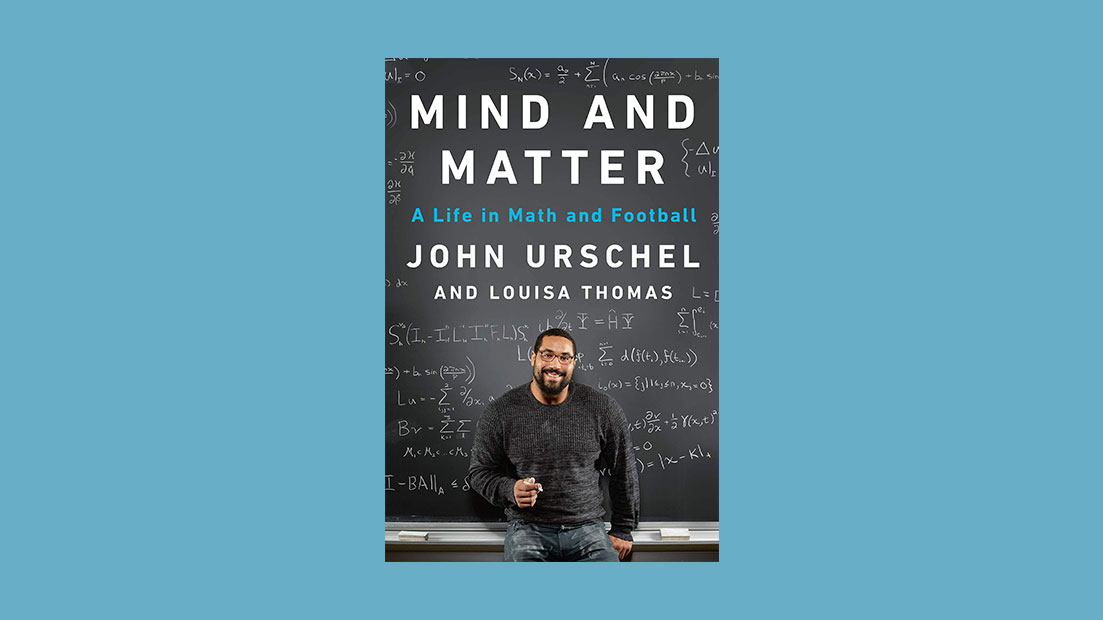The grad student who gave up football for math

It’s been nearly two years since John Urschel retired from the NFL at age 26. The former offensive lineman for the Baltimore Ravens is now a full-time graduate student at MIT who spends his days in Building 2, poring over academic papers and puzzling over problems in graph theory, machine learning, and numerical analysis.
In his new memoir, Mind and Matter: A Life in Math and Football, co-written with his wife, journalist and historian Louisa Thomas, Urschel writes about how he balanced the messy, physically punishing world of football with the elegant, cerebral field of mathematics. “So often, people want to divide the world into two: matter and energy. Wave and particle. Athlete and mathematician,” he writes. “Why can’t something (or someone) be both?”
Before he could speak in full sentences, Urschel’s mother saw that he had a mind for patterns. At five, he got interested in football, too. “The only thing that set me apart from other kids when I played sports was my intensity as a competitor. I couldn’t stand losing,” Urschel writes of the fierce drive that earned him a full ride to Penn State. “[The term ‘student-athlete’] is widely considered a joke of sorts in America,” he says. “But it is possible to be good at sports while tearing it up in academics.”
A year after co-writing a paper with his advisor on the spectral bisection of graphs and connectedness, he was drafted by the Ravens. He played in 40 games, despite getting knocked flat with a concussion at training camp in 2015, shortly after being accepted to MIT.
Recent books from the MIT community
Being Material
Edited by Marie-Pier Boucher, former postdoc; Stefan L. Helmreich, professor of anthropology; Leila W. Kinney, executive director of arts initiatives at MIT and of the Center for Art, Science & Technology; Skylar Tibbits, SM ’10, associate professor of design research and director of the Self-Assembly Lab; Rebecca Uchill, PhD ’15; and Evan Ziporyn, professor and chair of the Music and Theater Arts Department MIT Press, 2019, $39.95
Primed for Success: The Story of Scientific Design Company
By Peter H. Spitz ’48, SM ’49 Springer, 2019, $119.99
Plate Tectonics and Great Earthquakes: 50 Years of Earth Shaking Events
By Lynn R. Sykes ’59, SM ’60 Columbia University Press, 2019, $35
The Titanic Effect
By M. Kim Saxton ’85, Todd Saxton, and Michael Cloran Morgan James Publishing, 2019, $17.95
Super Thinking: The Big Book of Mental Models
By Lauren McCann ’01, PhD ’06, and Gabriel Weinberg ’01, SM ’05 Portfolio/Penguin, 2019, $29
Digital Minimalism: Choosing a Focused Life in a Noisy World
By Cal Newport, SM ’06, PhD ’09 Portfolio/Penguin, 2019, $26
Send book news to MIT News MITNews@technologyreview.com or 1 Main Street, 13th Floor Cambridge, MA 02142
In the following weeks, he writes, “I’d reach for a theorem that I knew I knew, and it wouldn’t be there.”
He eventually regained his facility for math, along with, surprisingly, his need to compete on the field. After finishing the 2015 season, he arrived at MIT in January 2016 to begin his PhD.
“It was like stepping into my personal vision of paradise,” Urschel writes of his first walk through the chalkboard-lined hallways of Building 2, where “casual conversations quickly became discussions of open conjectures.” Urschel practiced with MIT’s football team each Monday that first semester but was reluctant to return to pro football that summer; in the fall, he couldn’t wait for Sundays and the prospect of cracking open a math book.
He retired from the NFL after a July 2017 New York Times article outlined a brain study of 111 deceased NFL players, showing 110 had signs of CTE, or chronic traumatic encephalopathy, associated with repeated blows to the head.
Since then, he has focused on research and become a teaching assistant for 18.03 (Differential Equations). He also visits local high schools to talk math and STEM.
“I’m a visible mathematician,” says Urschel, who hopes to become a university math professor. “I have a responsibility to try to help popularize math and remove some of its stigma.”
Keep Reading
Most Popular
Large language models can do jaw-dropping things. But nobody knows exactly why.
And that's a problem. Figuring it out is one of the biggest scientific puzzles of our time and a crucial step towards controlling more powerful future models.
The problem with plug-in hybrids? Their drivers.
Plug-in hybrids are often sold as a transition to EVs, but new data from Europe shows we’re still underestimating the emissions they produce.
Google DeepMind’s new generative model makes Super Mario–like games from scratch
Genie learns how to control games by watching hours and hours of video. It could help train next-gen robots too.
How scientists traced a mysterious covid case back to six toilets
When wastewater surveillance turns into a hunt for a single infected individual, the ethics get tricky.
Stay connected
Get the latest updates from
MIT Technology Review
Discover special offers, top stories, upcoming events, and more.